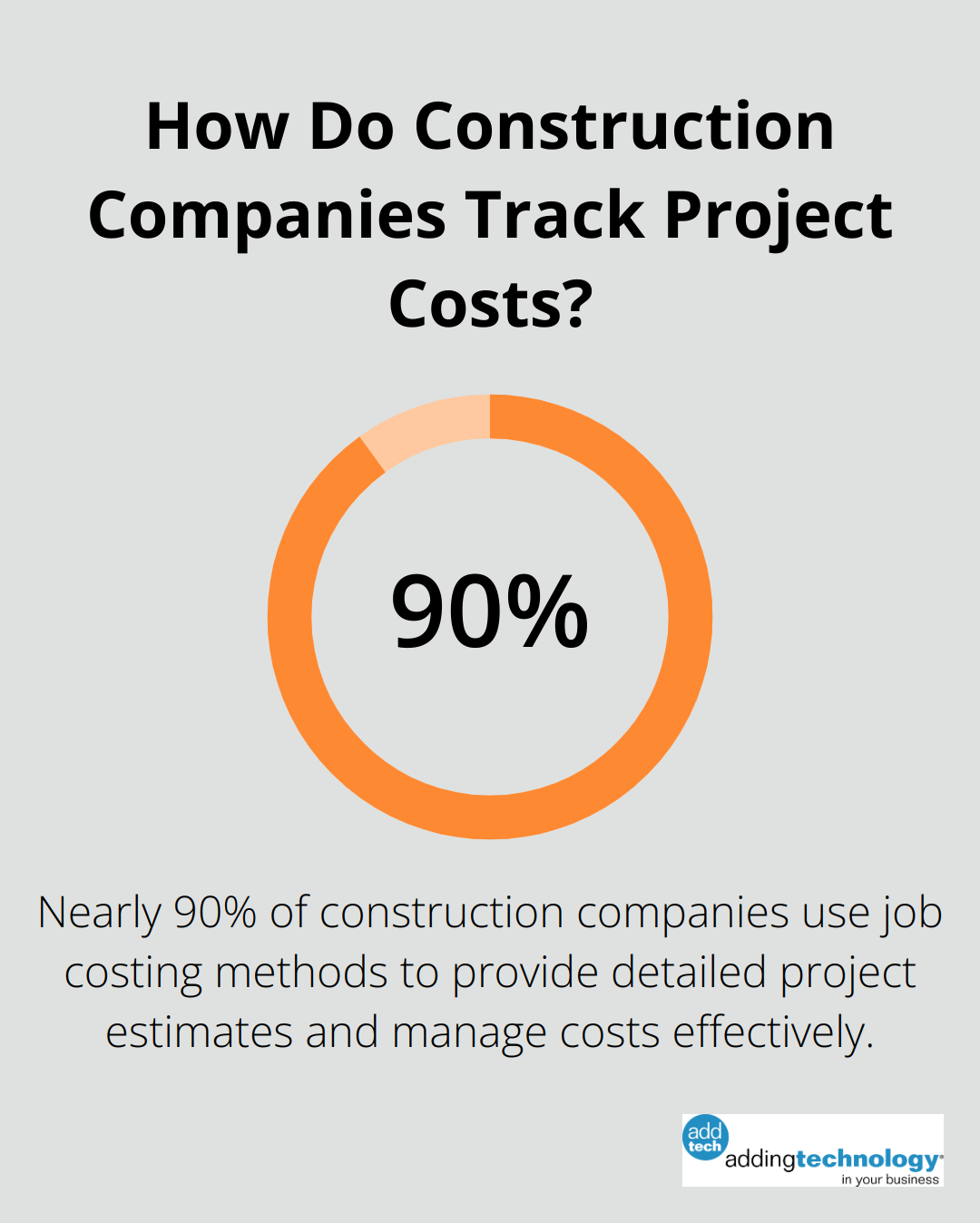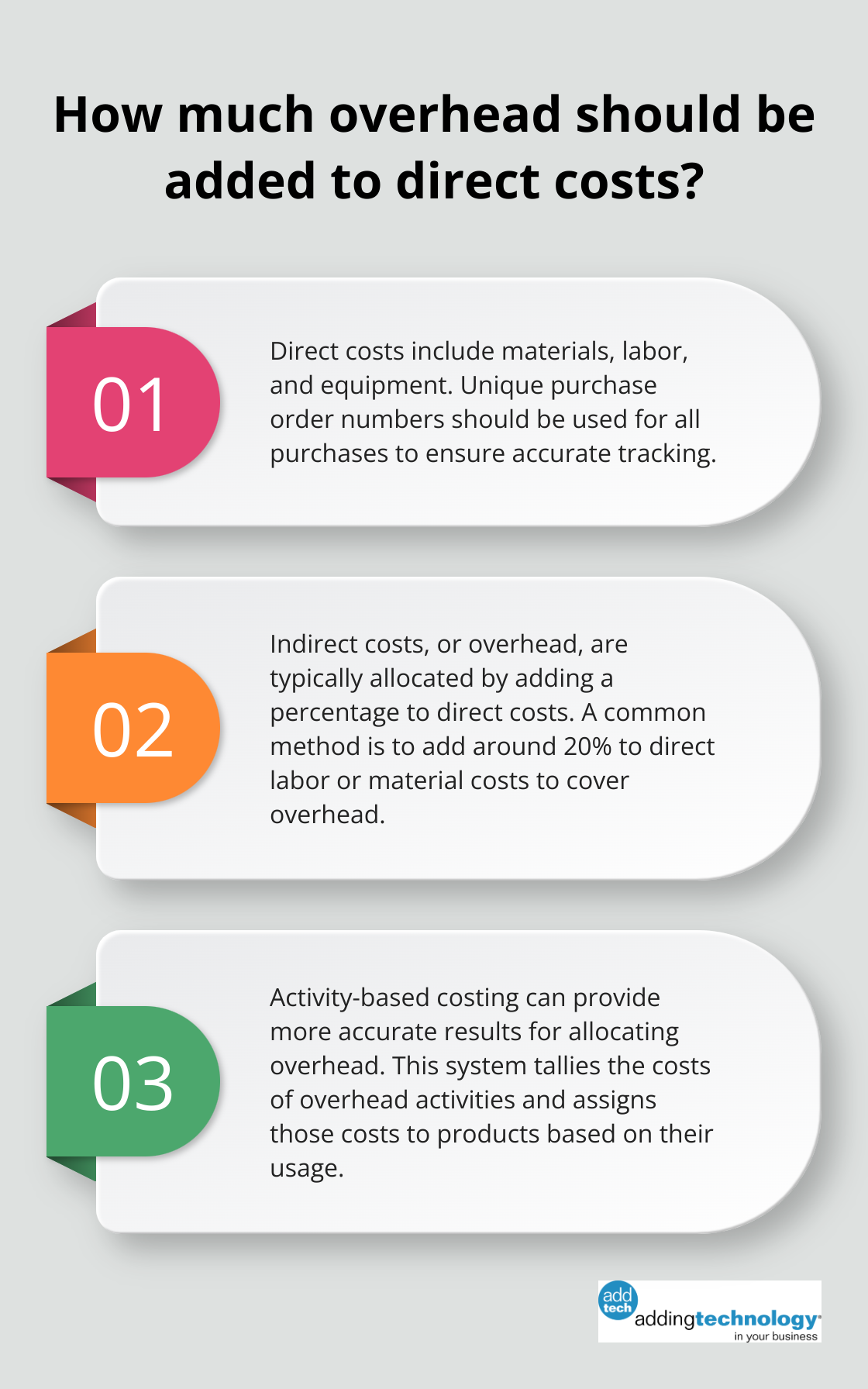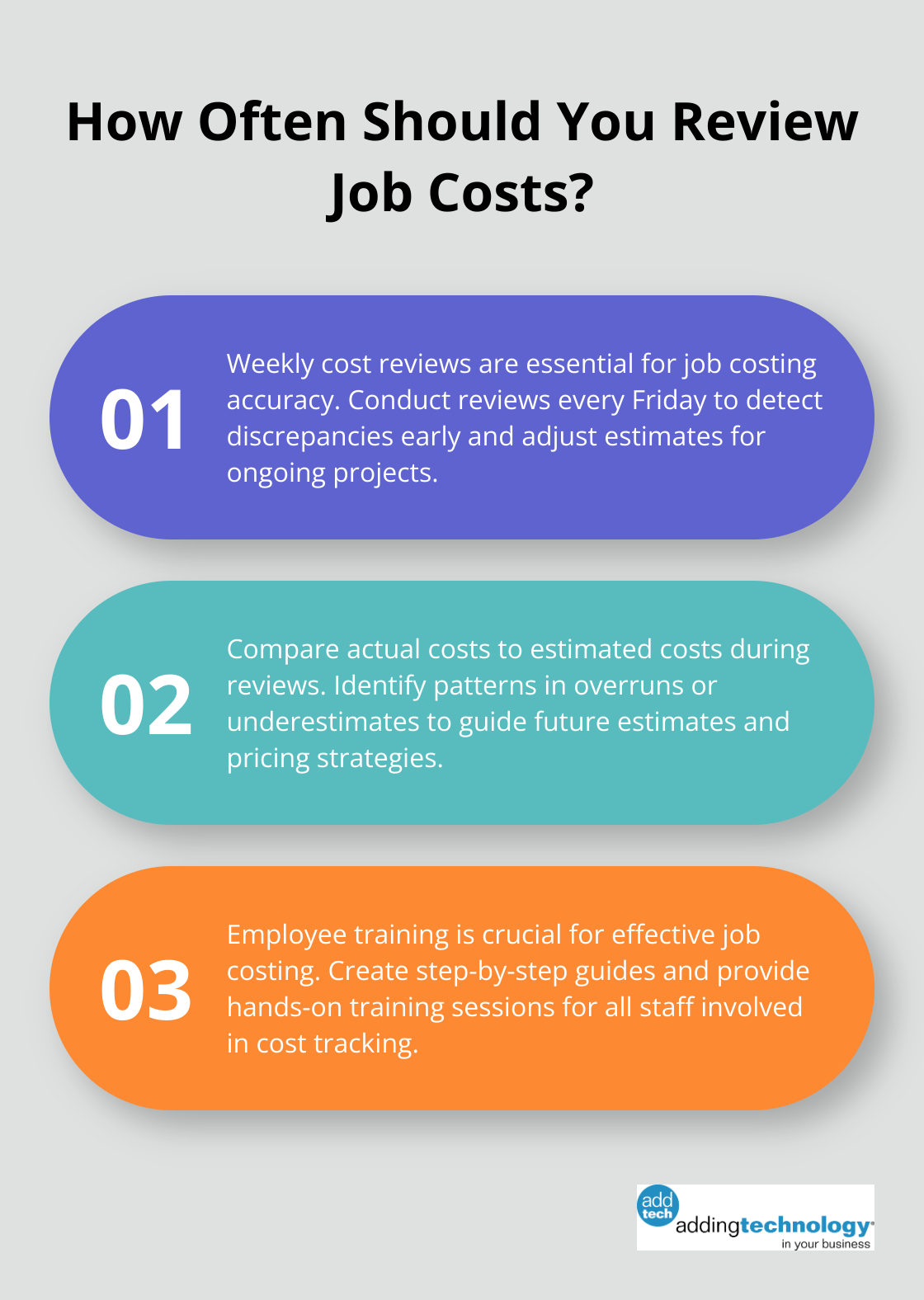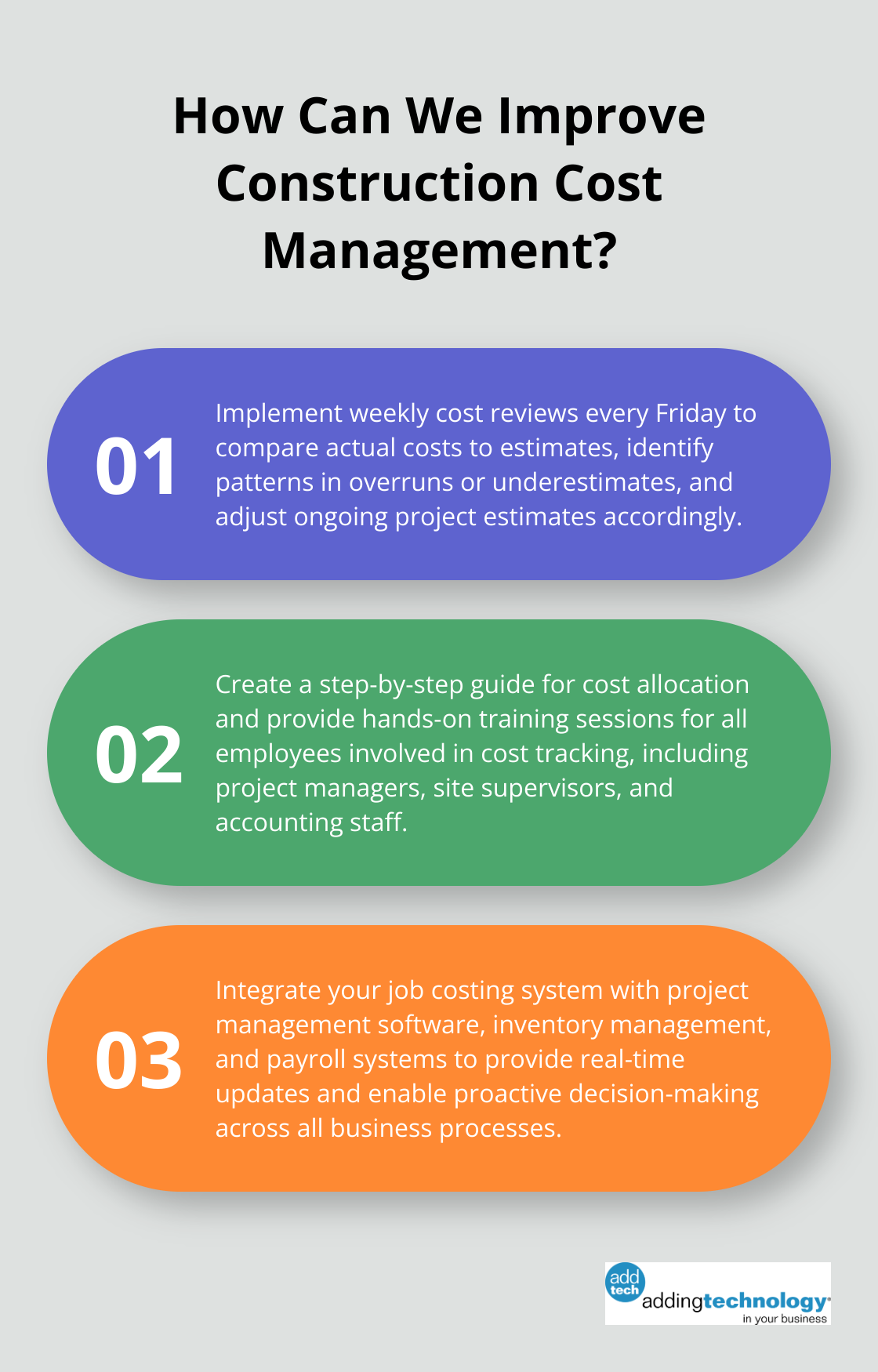
Job costing is a critical tool for businesses to accurately track and manage project expenses. At adding technology, we’ve seen firsthand how effective job costing can transform financial management and boost profitability.
In this post, we’ll guide you through the essential steps to implement job costing in your business, share best practices for accuracy, and highlight the long-term benefits of this powerful financial strategy.
Job costing is a method to track and allocate costs to specific projects or jobs. This powerful tool allows businesses to understand the true cost of each project they undertake. Job costing involves the identification and recording of all expenses associated with a particular job, including materials, labor, and overhead costs.

The key components of job costing are direct costs and indirect costs. Direct costs are expenses that can be easily traced to a specific project (such as materials and labor). Indirect costs, also known as overhead, are expenses that benefit multiple projects and need allocation across jobs (such as rent, utilities, or administrative salaries).
In a construction project, direct costs would include the lumber, concrete, and wages paid to workers on the site. Indirect costs might encompass equipment depreciation, office expenses, and insurance premiums.
Job costing is essential for construction firms. The National Association of Home Builders reports that nearly 90% of construction companies use job costing methods to provide detailed project estimates and manage costs effectively.
Job costing allows construction firms to:
When implemented correctly, job costing can significantly impact a company’s bottom line. Recent research has proposed a project analytics approach where Big Data is harnessed to understand the profitability distribution of different types of construction projects.
Job costing is more than just a financial tool-it’s a strategic asset that can drive business growth and success. It provides clear insights into project costs, empowers businesses to make data-driven decisions, and optimizes operations.
Modern job costing systems often leverage advanced software solutions to streamline the process. These tools can automate data collection, provide real-time job costing, and generate detailed reports. Companies like Adding Technology offer specialized solutions that integrate job costing with other financial management tools, making it easier for construction firms to implement and maintain effective job costing practices.
As we move forward, we’ll explore the essential steps to implement job costing in your business, ensuring you can harness its full potential to drive profitability and growth.
The first step in implementing job costing is to identify all direct costs associated with each project. These typically include materials, labor, and equipment. Create a detailed list of all materials used in each job, from lumber and concrete to nails and paint. Track labor hours meticulously, including wages and any job-specific benefits or bonuses. Don’t forget to account for equipment costs, whether you rent machinery or use your own.

Pro tip: Use unique purchase order (PO) numbers for all purchases to facilitate better job costing and ensure accurate tracking of supplies and materials. This simple step can save hours of work later on.
Indirect costs, or overhead, are trickier to assign to specific jobs. These might include office rent, administrative salaries, insurance, and utilities. A common method is to add a percentage-typically around 20%-to direct labor or material costs to cover overhead.
For more accurate results, consider using activity-based costing. This system tallies the costs of overhead activities and assigns those costs to products. For example, if larger projects require more administrative time, you might allocate a higher percentage of office costs to those jobs.
Establishing a system to track costs by job is essential. This system should allow for easy input of expenses and quick generation of reports. Train all employees on proper cost tracking procedures. Ensure that frontline workers can easily allocate expenses to the correct projects.
A key aspect of this system is a user-friendly coding structure. Establish a clear, logical system for assigning job numbers that conveys important information such as project year, activity, and the nature of expenditures. This makes it easier for everyone in the organization to accurately code expenses.
Selecting appropriate software is critical for effective job costing. General accounting packages often fall short in providing the detailed job costing capabilities needed in the construction industry. Look for construction-specific accounting software that offers features like job costing, work-in-progress reporting, and certified payroll.
The right software can revolutionize a company’s job costing process. Solutions like Sage 100 Contractor provide essential features for construction accounting, allowing you to monitor project costs as they occur and make timely adjustments.
Implementing job costing is not a one-time event but an ongoing process. Schedule regular reviews (weekly or monthly) to ensure your system remains accurate and effective. These reviews allow you to identify any discrepancies, adjust your processes, and continuously improve your job costing accuracy.
With these steps and the right tools, you’ll master job costing and improve your business’s financial health. The next section will explore best practices to ensure your job costing system remains accurate and effective over time.
Weekly cost reviews are essential. Set aside time every Friday to examine your job costs. This practice allows you to detect discrepancies early and adjust estimates for ongoing projects.

During these reviews, compare actual costs to estimated costs. Identify patterns in overruns or underestimates. Are material costs consistently higher than expected? Do labor hours exceed projections? These insights will guide your future estimates and pricing strategies.
Your job costing system’s effectiveness depends on the quality of data it receives. Invest in comprehensive training for all employees involved in cost tracking (project managers, site supervisors, and accounting staff).
Create a simple, step-by-step guide for cost allocation and provide hands-on training sessions. Consider implementing a buddy system where experienced staff mentor newcomers. Job costing helps contractors avoid project-sinking scenarios and manage labor effectively.
Job costing should not exist in isolation. Integrate it with other business processes for maximum impact. Connect your job costing system with project management software, inventory management, and payroll systems. This integration provides a holistic view of your projects and eliminates data silos.
For example, when a project manager updates the project timeline, your job costing system should automatically adjust labor cost projections. When inventory is used on a job site, it should immediately reflect in the job’s material costs. This real-time integration allows for proactive decision-making and prevents end-of-project surprises.
Your past projects contain valuable information. Use this historical data to refine your estimates and improve future job costing accuracy. Analyze completed projects to identify trends in cost overruns or savings. Were certain types of projects more profitable? Did specific clients or locations present unique challenges?
Create a database of historical job costs, categorized by project type, size, and location. Use this data to inform your bidding process and project planning.
Implement advanced software solutions to streamline your job costing process. These tools can automate data collection, provide real-time job costing, and generate detailed reports. Adding Technology offers specialized solutions that integrate job costing with other financial management tools, making it easier for construction firms to implement and maintain effective job costing practices.
Job costing transforms businesses, especially in construction. It provides invaluable insights into financial performance and operational efficiency. Companies that implement effective job costing can price projects accurately, identify cost overruns early, and improve project management.

Businesses should assess their current systems and identify areas for improvement in their job costing processes. This might involve upgrading software, refining cost allocation methods, or providing additional training to staff. Companies can also consider partnering with experts in the field to optimize their job costing practices.
We at Adding Technology specialize in helping construction businesses implement and optimize their job costing processes. Our solutions can help streamline your financial management, ensuring you have the tools and insights needed to drive your business forward. With the right approach and tools, job costing can become a powerful driver of growth and success for your construction business.









At adding technology, we know you want to focus on what you do best as a contractor. In order to do that, you need a proactive back office crew who has financial expertise in your industry.
The problem is that managing and understanding key financial compliance details for your business is a distraction when you want to spend your time focused on building your business (and our collective future).
We understand that there is an art to what contractors do, and financial worries can disrupt the creative process and quality of work. We know that many contractors struggle with messy books, lack of realtime financial visibility, and the stress of compliance issues. These challenges can lead to frustration, overwhelm, and fear that distracts from their core business.
That's where we come in. We're not just accountants; we're part of your crew. We renovate your books, implement cutting-edge technology, and provide you with the real-time job costing and financial insights you need to make informed decisions. Our services are designed to give you peace of mind, allowing you to focus on what you do best - creating and building.
Here’s how we do it:
Schedule a conversation today, and in the meantime, download the Contractor’s Blueprint for Financial Success: A Step by-Step Guide to Maximizing Profits in Construction.” So you can stop worrying about accounting, technology, and compliance details and be free to hammer out success in the field.